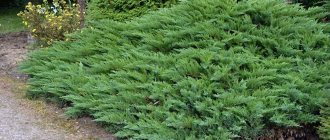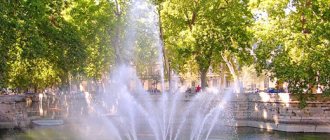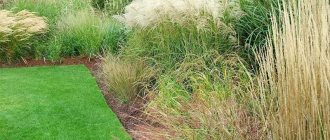In practice, an artificial hill in suburban areas is usually built more for aesthetic reasons, guided primarily by the desire to give a more beautiful look to your site and introduce fresh ideas into its landscape design.
Of course, there are also very good reasons for constructing a hill for practical reasons: a hill can be used as an effective means of hiding all objects on the site, the appearance of which may well leave much to be desired: a manure pit, a toilet, other old unsightly buildings, low-lying places, etc. d.
Let's look at the basic principles of building an artificial hill with your own hands in summer cottages.
Hill and plot dimensions
These two quantities are somewhat dependent: the larger the size of the plot, the higher, other things being equal, the hill can be.
In practice, the maximum height of a hill is usually limited to 1.5 m. The height of the most common hills usually does not exceed 1 m.
It should be noted that the hill will look good only on plots of 1000 square meters or more. m (10 acres). In areas with a small (less than 10 acres) area, the hill usually looks awkward due to its strong prominence against the background of the entire such area.
Let's start with analysis
For the territory, it is necessary to conduct a topographic survey, measure the elevation difference, and draw up a detailed plan taking into account the existing relief. It will become a support for the vertical planning of the site. In carrying out this task, you need to solve a number of practical problems:
- diversion of surface water away from the house, playgrounds, parking lots, paths, discharge of wastewater to the lowest point on the site;
- if roads or other areas are located higher up, protection from flooding with water that will drain from them;
- load distribution, soil protection from sliding;
- zoning taking into account the expected illumination, wind rose, degree of slope.
Before design, a soil analysis is performed. It will help determine how stable the rocks are to form a slope or hill. If it is sand, sandy loam, remains of construction waste, or an artificial embankment that can “creep,” the slopes will need to be strengthened.
Another important task is to assess the groundwater level, its sources, current direction, and pressure. In an area with complex terrain, reliable, productive drainage is needed, which will help protect low-lying areas from waterlogging and slopes from washing out.
Evaluate the general characteristics of slopes:
- The steeper the slope, the more the soil will be susceptible to erosion, washing out, and sliding. If the slope is gentle, arranging terraces or retaining walls is sufficient. If it is steep, additional soil reinforcement may be required;
- at the top of the slope it will always be hotter, drier, and the wind will be stronger here. The lowlands are cooler and have more moisture. This is taken into account when planning landscaping;
- The orientation of the irregularities relative to the cardinal points is important. The northern slope will be shaded and cold, the southern slope will be sunny.
Hill shape and volume
A simple hill is made in such a way that its slopes form an angle relative to the ground (base) that does not exceed 45 degrees, since otherwise, due to the action of gravitational forces, the collapse of its too steep slopes is quite possible.
More complex forms of hills are made using terracing, the description of which is beyond the scope of this article.
When designing a hill, an approximate calculation of its volume is important.
You should know that no matter the size of the hill, additional building material will be required to fill its volume. Moreover, the larger the hill and the higher it is, the more additional building materials will obviously be required.
The work procedure includes the following main stages:
When and how to prune roses in autumn for winter: tips and step-by-step instructionsA decorative cart is a beautiful option for landscape decoration, see options and ideas on how to make a cart with your own hands (photos and videos)
- A beautiful decorative mill is a way to decorate your site in an original way without much effort, see how to make a mill with your own hands!
- clearing soft soil and laying the foundation for the future hill;
- erecting a hill frame and laying fertile soil on its slopes;
- planting plants.
What is geoplastics?
Geoplastics is the creation of artificial relief on the ground. This science is an excellent way to diversify the image of a personal plot, making its space more simple, complex or expressive. Science also makes it possible to correctly zone a territory, turn its individual sections into recreation areas, cozy corners, hidden from prying eyes and noise. Among other things, it has a decorative value and helps make the site more aesthetically pleasing.
Landscape design of a personal plot
Geoplastics also changes the level of insolation, wind and temperature conditions, hydrological and structural-soil conditions, due to which it becomes possible to grow certain crops in a certain area. It can give the site originality, hide ugly buildings, disguise the utility block, and provide new opportunities for viewing the territory.
Technically, all geoplastics tasks are performed by changing the relief due to the construction:
- hills;
- bodies of water;
- embankments;
- shafts;
- craters;
- walls;
- stairs;
- canyons;
- dams;
- slide;
- amphitheatres;
- rockeries;
- rock gardens;
- artificial depressions.
Externally, most types of relief that are formed with the participation of geoplastics are close to natural, simply copied from the natural environment. For example, in nature, many gardens and parks are located on the slopes of hills, and in the conditions of a local area, this can be successfully repeated, albeit on a smaller scale.
How to properly prepare a place for a future hill?
First of all, you should remove the topmost (fertile) layer of soil from the place designated as the base of the future hill and set it aside until the final stages.
You should also take care of the soil for the hill frame in advance. Instead of soil, you can effectively use concrete, reinforced concrete and metal structures that have already served their purpose.It is not worth filling the body of the hill with garbage because of its rapid decomposition and, as a result, the subsequent strong shrinkage of the entire hill.
Natural materials that are well suited for these purposes are stones, crushed stone, and sand. It is not recommended to use clay due to its pronounced heaving properties.
Features of the construction of a retaining wall
A retaining wall is one of the key elements of geoplastics. It is used in the construction of terraces, steps, cutting off groundwater, securing slopes and zoning the site.
In order for this design to perform its function properly for many years, it is worth taking care of some points:
- Choose the right material for fixing soil masses . If we are talking about small flower beds, then boards or beams dug vertically into the ground will be enough. In order to keep a significant mass of clay soil from collapsing, it is worth using massive materials.
- Water is the enemy of a retaining wall's strength . Moisture that has saturated the soil and subsoil layers makes them much heavier. All this mass begins to put pressure on the retaining wall, which can collapse and shift. In such cases, a strip foundation should be built for the retaining wall, which will prevent a row of stones or blocks from slanting or sagging under the pressure of a large mass.
- An entire retaining wall can be built from concrete penetrated with reinforcement - it will have enormous displacement strength. True, concrete looks unsightly - it should be covered with wild stone or textured tiles. True, this design has a significant disadvantage - it cannot be disassembled.
Are there geoplastic elements on your site?
Of course! I want to do it
- One of the best building materials for a retaining belt is interlocking stone block . They can be made of stone (very expensive) or from pressed slag and concrete. At the back of the blocks there is a protrusion with which they cling to the previous row - this provides additional stability.
- An important point is the organization of drainage . Drainage pipes are used for this. One pipe is laid at the bottom of the wall on the side of the soil mass, the other - closer to the surface. The pipe must be placed in a jacket made of coarse crushed stone and wrapped in geotextile so that clay particles do not clog the drainage holes. The pipe is laid at a slight angle so that leaked moisture flows down.
Hill frame construction
The principle of work itself is as follows. First, the base and underlying part of the hill are prepared.
Creating a rock garden - features of application in landscape design. 145 photos of the most beautiful design elementsFruit seedlings: how to choose a variety
- Do-it-yourself mailbox - a detailed description of how and what to make a beautiful and convenient mailbox for letters (80 photos and videos)
To do this, use non-heaving or low-heaving soil (for example, coarse or medium-grained sand), which, having been previously moistened to increase its bulk density, is poured layer by layer at the location of the base of the hill and compacted manually or using a tamping machine.
After the base for the hill has been prepared, they begin to form its main part: for this you can use either the ready-made structures mentioned above, or pre-prepared soil.
At the finishing stage, the top and slopes of the hill are formed. To do this, previously deposited fertile soil is poured into the location of the proposed future hilltop.The soil rolls down under the influence of gravity, naturally forming the top and sides of the hill.
What kind of irregularities can there be?
Lowland. It may be small, located in a certain part of the territory. If the depth is great and the area is limited, you can build a pond by further deepening this area. Another option is to create a dry stream with a bridge thrown over it. The lowland is clearly visible from a height, and therefore you can arrange a beautiful, bright flowerbed in it and plant ornamental plants (provided that they have enough light). If the soil is waterlogged, it is better to plant moisture-loving species and varieties. Another option is to install drainage. If the entire area is low-lying, assess the levels of neighboring areas. If they are located higher and there is a risk of flooding, you need either good drainage with the organization of “interception” and removal of surface water, or adding soil and raising its level. Before backfilling, drainage must be organized and drainage of both groundwater and surface water must be ensured. It is better to fill the area with permeable soil.
Ravine. Usually appears due to disturbances in land use. The problem with such areas is the rapid deepening and increasing length of the ravines. To avoid this, surface water must be diverted away from it. If the ravine is small, it can be filled with clay soil, compacting each layer. If it is large enough, the slopes are strengthened with turf and plants with developed root systems. Before planting, you can strengthen the soil with geogrid. At the bottom of the ravine you can make a dry stream or form a shaded recreation area. You can and should use stones in its design. This is beautiful and “useful” for the site: boulders can strengthen the bottom and walls of the ravine.
Slope. If it is flat, it needs to be specially strengthened. You can make a terrace and install retaining walls to level the ground. Another option is to landscape the slope using plants that can strengthen the soil. It can be mahonia, spirea, quince, cotoneaster, hazel. If the slope is large, it is recommended to install terraces and use ground cover plants in landscaping. For each “step” of the terrace, drainage is installed with outlet into a common side ditch. Steep slopes can be strengthened with geogrids, protecting the soil from sliding, washing away, and blowing out. You can “break up” the slope with retaining walls, but it is better if there are not too many of them. Instead of them or together with them, reinforced slopes can be used. They look more natural and fit well with the landscape style.
Hilliness. The slope can be variable, and unevenness can alternate with hills. To use such a site, a “network” of stairs or terraces is created. It is better if the steps are wide enough and gentle enough to make the ascent and descent comfortable and safe. Hills are used for arranging rock gardens and rockeries, installing small architectural forms, and creating viewpoints. Ornamental moisture-loving and shade-tolerant plants are planted in the lowlands.
Elevation. Local elevation on the site can interfere; often they are simply torn down instead of used. You can do without this by arranging a children's playground on such an elevation. The steep slope can be used as a base for a climbing wall or a finished slide. A gentle slope can be “broken” into several levels with different play equipment on each level. Another option is decorative compositions. Located on a hill, they will be clearly visible from anywhere in the garden and dominate its design. This could be a rock garden, rock garden or rock garden. Another option is combinations of trees and shrubs. More often, such compositions are landscape, emphatically natural, but they can be designed in both regular and any ethnic styles.
carries out landscaping and landscaping for areas with complex terrain, creating landscape gardens, recreation areas, etc. It is possible to arrange reservoirs, profile, build retaining walls, strengthen slopes, and carry out other work.
Photo of artificial hills on a summer cottage
Did you like the article? Share

0
When not to disturb the terrain
Geoplastics mainly helps nature, but in some situations it can also cause harm and disrupt the ecosystem of the site; there is no need to use geoplastics in the following cases:
- Wetland;
- A large number of trees not intended for cutting down;
- Possible seismic activity;
- Soil looseness.
If you are not sure whether to plan and apply geoplastics on your site, it is better to consult with experts in this field. Modifying the relief is quite a fascinating activity, but it should be approached with special attention and a deep study of the issue. Geoplastics in landscape design, done competently with your own hands, can radically change even the most unsuccessful area.
Ways to strengthen slopes
When the site is on a slope, any improvement option involves excavation work to level the terrain. If the territory is left unchanged, the top layer of the earth will gradually be destroyed by precipitation. On uneven slopes there is a high probability of collapses and landslides. Strengthening the soil layer is necessary. Plants with a strong root system are planted on flat areas. Slopes of more than 70 degrees are reinforced or leveled.
Shrubs with a strong root system will serve as a natural strengthening of the slope
Strengthening with geomaterial
Environmentally friendly materials are used for installation. First, geotextiles, a non-woven material made of polyesters and propylene fibers, are spread on the ground. Fix on top:
To strengthen the soil surface, geogrid or geogrid is used depending on the steepness of the slope
- geogrid - a fiber lattice fabric that looks like a welded reinforcing mesh;
- geogrid - a grid of dense bioresistant tapes, between which gravel is poured or concrete is poured;
- gabion – a metal frame of a certain shape, filled with crushed stone or pebbles.
Options for strengthening the slope of the terrace
A soil layer is poured over the strengthening or natural stone is laid. On fortified areas you can sow herbs, flowers, and plant small shrubs.











